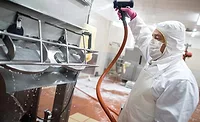Top 3 Tips for Effective Sanitation Chemical Use
Chris Celusta, Manager Food Processing Sanitation with Spartan Chemical Co. Inc., a leading U.S. manufacturer of chemical specialty maintenance products, spends a lot of time in food processing plants assisting customers in handling the changes in environmental sanitation. In educating sanitation crews, Celusta uses a simple analogy to communicate the need to stick to basics for proper handling and application of cleaning chemicals.
“Whatever type of sanitation program you’ve got in place, each element has to be fundamentally sound,” says Celusta. “I use the analogy of sports teams. Whether you are a rookie or a veteran, you go to preseason training where the emphasis is on back-to-the-basics. Good coaches know that the better the players execute the fundamentals, the better the team is going to be.
“It’s the same for sanitation teams. You have to go back to the basics to be successful on a consistent basis. In sanitation, personnel turnover is a problem. It is constantly necessary to retrain new employees, and it doesn’t hurt the veterans to go back and remind themselves of the little things that make a difference. Everyone needs to know why we clean. It is important because if they don’t do their job, then the facility doesn’t produce quality and wholesome products.”
“The sanitation chemicals handling and storage program, in particular, has to be practical, safety-oriented and viewed as a continuous improvement type of program,” he adds. “If you don’t update this fundamental program regularly, your people are going to do something that will harm other people.”
Top Tips for a Winning Chemical Handling Program
On Celusta’s list of fundamentals are three top tips for overcoming challenges in food processing associated with handling cleaning detergents and sanitizers that protect employee health and prevent chemical contamination:
1. Know your product and processes and select sanitation chemicals accordingly. “First, you’ve got to identify the soils that you want to remove, and to do that you need to know the product you are making, the processes by which it is made, and the particular challenges of your plant environment,” Celusta says. “This is the only way that you will be able to maintain an effective cleaning and sanitizing program.”
“Some products clean, dilute or foam better. Some are more user-friendly.” states Celusta. “The food plant really needs to define the product, application and soil they are trying to remove. The sanitarian needs to consider the benefits of a good foam cleaner, contact and dwell times. Maybe incorporate some type of agitation or mechanical action, whether a brush, a green pad, etc. The right product with the right equipment equals a reduction in cost and labor.”
Sometimes it’s as simple as defining the product. “Many people don’t understand detergents,” he adds. “Previously, detergents were referred to as ‘soap,’ but detergents are much more sophisticated. Detergents actually wet the surface, which loosens up whatever soil is being removed. A good detergent will penetrate and get down into the dirt film. This makes it easier to remove the soil from the surface.”
2. Ensure that sanitation chemical containers are properly labeled, and that directions on the label are followed. Some food plants use laminated, color-coded labels and training cards for acids, alkalies, sanitizers and caustic based products. This acts as a visual alert to personnel who are handling various chemicals. In this case, says Celusta, food processors must make sure that the color-coded labels are on every container holding chemicals. The laminate can withstand the day-to-day abuse of a cold, wet environment found in many food processing situations. “And in most situations, labels are needed in both English and Spanish.” reminds Celusta. “Today’s multicultural workforce reminds us to know our audience.”
“Following use instructions is critical for a variety of reasons, he adds. “More is better” ( i.e., glug, glug) is a term of the past—we hope! Personnel need to know that the directions on the label are a benefit: One, this is how the product works, and two, mixing the product at the right dilution is going to remove the appropriate soil from the surface and make it easier to rinse. Using too much product requires additional rinsing to remove the excess residual--negating potential cost-savings.”
3. Use the right equipment to dispense or apply sanitation chemicals. Equipment manufacturers have developed wall-mounted foamers, portable foamers and other dispensing equipment that enable sanitarians to obtain product consistency and results daily. But more importantly, notes Celusta, the newer dispensing equipment allows the sanitation supervisor to stay within his/her budget.
The right equipment minimizes human error, reduces personnel exposure to strong chemicals, and provides flexibility to the plant for more effective applications. “Clearly, portable foamers or wall-mounted units allow the facility flexibility when applying cleaning and sanitizing solutions, plus each product is automatically pre-measured from the dispenser. If the soil load changes because there has been a heavy day of processing, the plant can make adjustments and still maintain consistency and performance from the sanitation chemicals.”
www.spartanchemical.com
Looking for quick answers on food safety topics?
Try Ask FSM, our new smart AI search tool.
Ask FSM →







